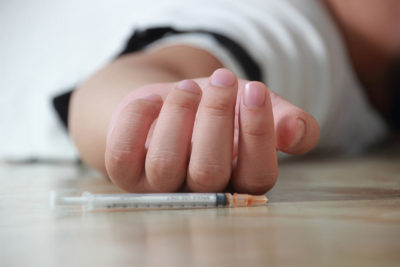Preventing an Opiate Overdose with Naloxone

Today, a 2016 fact sheet from the American Society of Addiction Medicine shows how annual figures for fatal overdose have ballooned in recent years, with roughly 19,000 deaths from prescription painkillers and another roughly 10,500 deaths from heroin now the new annual norm.
Statistics like these have centered recent public policy discussions around the goal of preventing opiate overdose. The good news is, there is already a drug that when administered in a timely way can save lives from opiate overdose, by stopping an overdose in its tracks. Naloxone has been in use for years by medical and law enforcement first responders during overdose emergencies. The drug is now available to the greater public in two forms: a nasal spray, Narcan, and a hand-held auto injector called Evzio, both of which have been approved by the Federal Drug Administration for at-home use by family members, caregivers and other non-medical personnel. This article will educate readers on what they need to know about preventing an opiate overdose using naloxone, by answering common questions and pointing readers in the direction of other helpful resources.
How Naloxone Works
Naloxone is an “opioid receptor antagonist,” meaning it competes with opiate drugs like heroin in a binding contest for some of the same opioid receptors. Naloxone’s advantage is that it can attach to these same receptors faster than opiate drugs, thereby displacing these drugs and (when administered in time) reversing the potentially fatal respiratory depression caused by opiate drugs. A single dose of naloxone injected into the muscle or under the skin (via Evzio), or delivered through the nose (via Narcan) has reportedly been found to prolong one’s life in time for emergency medical responders to arrive.
Signs of an Opiate Overdose
Naloxone has the best chances of effectively stopping a heroin or opiate overdose when it is delivered at the first signs of an overdose. These can include:
- Severe sleepiness
- Problems breathing
- Inability to respond and unconsciousness
The “opioid overdose triad” is a helpful general guideline for determining when an overdose has occurred. The triad consists of the following three signs and symptoms indicating overdose, according to the World Health Organization:
- Pinpoint pupils (or small, constricted pupils, which rarely occur due to other causes)
- Unconsciousness
- Respiratory depression
Common Concerns Regarding Naloxone
Some of the more common concerns regarding naloxone involve questions over the drug’s safety and effectiveness when administered by non-medical people, such as family members or friends of opiate users. The good news is that the drug has been safely used for many years now, going back to the early 1970s—and in its new forms of delivery, the nasal spray Narcan and the injection Evzio, is easy to administer as an overdose intervention.
Another concern is how to get a prescription for the drug in the first place, given some of the following barriers highlighted in a June 2014 article in Time:
- Lack of awareness about how to handle prescriptions for the drug on the part of many pharmacists and doctors, many of whom may still not know the drug can be prescribed outside of a hospital setting
- A small market for the drug—a fact that means few manufacturers (and in turn a lower supply and occasional shortages) and raises the drug’s price
- Limited insurance coverage (although Narcan is supposedly covered by 80 percent of insurance plans, according to its manufacturer)
- Lack of availability to the drug depending on place of residence. This year, for example, Narcan (the naloxone nasal spray) reportedly became available over the counter, meaning without a prescription, at Walgreens pharmacies in 35 states and Washington, D.C.
Such barriers may only be temporary. Growing public awareness, greater education among medical professionals, national pharmacy initiatives like that of Walgreens, more state and community distribution programs, and collaboration between the FDA and organizations like the National Institute on Drug Abuse and the Substance Abuse and Mental Health Services organization, mean that naloxone is increasingly making its way into the hands of more people who need it.
Another concern that emerging research has disabused thus far has to do with whether greater over-the-counter availability of naloxone will only end up actually discouraging opiate users from getting treatment for an addiction. “Won’t the notion that one easily accessible and affordable dose of Narcan stops an overdose only end up leading to more harmful drug-using behavior?,” goes this line of questioning. On the contrary, existing data from studies into community overdose prevention programs suggest that the opposite is true, and that naloxone is attributed with reductions in drug use.
Moreover, naloxone in its take-home forms is strictly prescribed as a life-saving measure in situations where emergency medical assistance is necessary. (Naloxone can wear off before heroin, for example, so it remains critical to call “911” or go to one’s nearest emergency room in cases where naloxone has been administered.) The prescriptions for Narcan and Evzio thus direct users to call emergency medical assistance.
How to Stop an Overdose Using Naloxone
It is not difficult to stop an overdose using naloxone. The Harm Reduction Coalition has provided some helpful directions for how to do that, along with clear, helpful images demonstrating each step. Additionally, the Evzio website offers an instructional video about how to use its pocket-sized naloxone auto-injector. Some simple directions for administering naloxone via the nasal spray Narcan are here.
SAMHSA’s Opioid Overdose Prevention Toolkit is another trusted resource for preventing overdose.
Finally, it is important to remember that naloxone saves lives but isn’t a cure for addiction. If you find yourself in circumstances where you or a loved one needs naloxone in order to survive an overdose, you may have a substance use disorder that needs urgent medical attention. Naloxone can be the first step—and a wake-up call—in connecting with professionals who can help.

